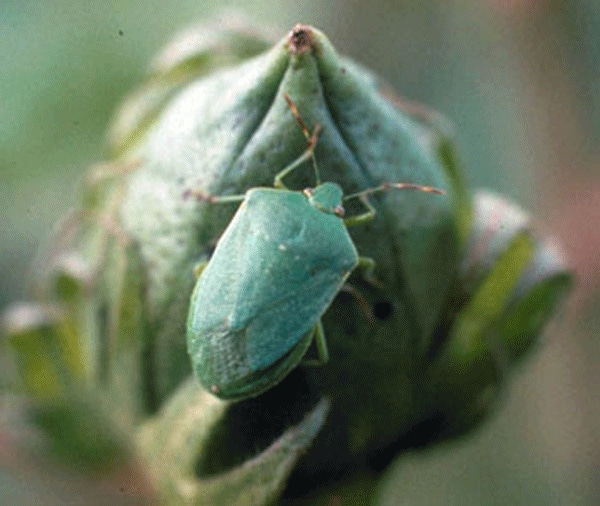
• The consultant’s responses tell us not only the status of major and minor pests across various local production areas of the state (producer/client groupings), but also reveal reliable insecticide use patterns and how insecticide use is partitioned across our major late-season stink bug/bollworm complex.
April 9, 2013

Our annual North Carolina Consultants Cotton Survey provides a realistic picture of the status of our cotton major insects and how they were managed by a group that accounted for approximately one third of our state’s total cotton acreage in 2012.
All 25 licensed, independent consultants surveyed returned the completed survey forms this past year.
Because their advice is based on both considerable plant and pest-related experience, extensive sampling, insect and damage recognition and use of up-to-date thresholds, their responses tell us not only the status of major and minor pests across various local production areas of the state (producer/client groupings), but also reveal reliable insecticide use patterns and how insecticide use is partitioned across our major late-season stink bug/bollworm complex.
Thrips: In 2012, 92 percent of our consultants’ total client cotton acreage was treated with a follow-up foliar spray for thrips, very much in line with the rest of our state.
Because we presently rely on follow-up foliar sprays for thrips, timing these sprays to the first true leaf stage should be emphasized to producers in general.
Herbicide/insecticide combination sprays that coincide with the third or fourth true leaf stage are too late for effective control of thrips.
On the plus side, evaluations of ultra-high seed treatment rates and an in-furrow, at-planting spray coupled with a seed treatment have looked promising in early testing and may even hold the promise of avoiding those routine follow-up foliar treatment for thrips.
These and other tests will be greatly expanded throughout the Southeast in 2013.
Cotton aphid resistance: Only 5.3 percent of our consultants’ client acreage was treated for cotton aphids in 2012. However, one consultant in Gates County found a cotton aphid population that was resistant to chloronicotinoids, our mainstay against this pest.
This resistance was subsequently confirmed in the lab at Mississippi State University.
Another consultant found probable nicotinoid-resistant aphids in several cotton fields in far eastern North Carolina in 2011. However, Hurricane Irene wiped out the opportunity of confirming resistance. We hope to have more aphid samples taken in 2013 to help determine the range of this resistance.
The major factor contributing to this increased resistance is our widespread use the nicotinoids in all cottonseed treatments, in many of our plant bug sprays, in pyrethroid-nicotinoid copacs (i.e., Endigo and Leverage 360), and in essentially all of our cotton aphid sprays.
Beneficials help control outbreaks
One huge factor in our favor, however, is the high degree to which predators, parasitoids and disease pathogens control aphid outbreaks in most years.
Spider mites and rain: Possibly because most producers avoided the droughty conditions under which spider often mites thrive, only 1.1 percent of the consultants’ client acreage was treated for this pest in 2012. So our more generous weather patterns were a help in more ways than one.
Plant bugs increasing? Plant bugs were another story, however. Although consultants’ producers treated an average of approximately 6 percent of their acreage for plant bugs between 2004 and 2007, in 2012, almost 20 percent of their cotton acreage was treated for plant bugs.
As is often the case, plant bug levels and damage tends to increase farther east, particularly in the Blacklands and Tidewater areas of North Carolina.
The clients of two consultants working in our far eastern counties sprayed 100 percent of their cotton fields for plant bugs in 2012, so plant bugs in some areas and/or years can be an economic concern.
It will be interesting to find out in the next few years if this trend toward increasing plant bug levels on cotton in North Carolina continues.
Stink bug and bollworm duel threat: On the survey form, our consultants were asked how many times their clients had to treat for late season bollworms and stink bugs in 2012 and which was the primary pest or pest complex.
Their producers treated an average of 1.53 times for the stink bug/bollworm combo, with the stink bug the dominant target 92 percent of the time.
Remember, however, that caterpillar control is not free — Bt technology fees see to that.
Cotton insect pest ranking: Our consultants ranked our five 2012 “major” cotton insect pests from worst to least damaging. Stink bugs took the top spot, followed by thrips, plant bugs, and bollworms, with cotton aphids taking a distant fifth.
In previous years, thrips often edged out stink bugs for the No. 1 ranking.
Additionally, thrips management requires considerable up-front costs in the form of seed treatments and most often the follow-up spray mentioned above.
One consultant considered plant bugs and one regarded bollworms as his/her most damaging pest in 2012.
Communication preference: When asked if they preferred conventional (articles in trade journals, bulletins, manuals, handouts, etc.) or more high tech means of Extension specialists’ communication of information (web sites, blogs smart phone apps, etc), a decided preference toward electronic communications was expressed — to the tune of 89 percent.
Hopefully, we specialists can put increasingly more of our outreach effort onto up-to-date, timely and relevant electronic communication in our quest to reach greater numbers of our consultant, agent and producer clientele base in a cost-effective manner.
You May Also Like



